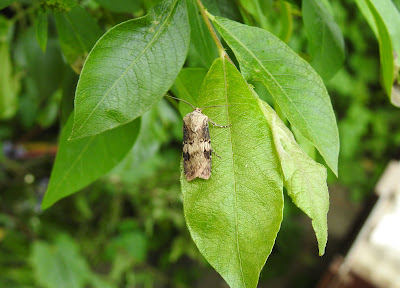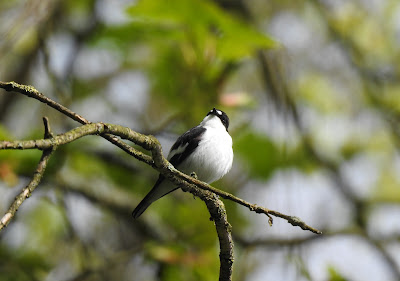Earlier in the week Gail and I had a walk along the quay again, and it was a pleasantly warm morning with five oktas cloud cover. Migration has slowed down now, as it does in late May, but we did have a singing Whitethroat from an area that I haven't recorded them before. It is possible that it was a late migrant, but the habitat is suitable for a breeding bird. Time will tell.
We had our eyes firmly fixed groundward as well, looking for a few more plant species, and we had a couple of Common Blue butterflies. The main food plant for the caterpillars of Common Blue is Common Bird's-foot Trefoil, and other plants used include White Clover and Lesser Trefoil, all of which occur along the quay.
We added a few more plant species, including Oxeye Daisy, Common Comfrey, Sea Plantain and Biting Stonecrop, taking our total for the quay to 47 species.
Yesterday, Gail and I were back in Bowland checking our Pied Flycatcher boxes, and we needed to lift the last remaining female of the five pairs from the nest, if possible, and we also needed to trap the males if any of the chicks had hatched.
We set traps in two of the Pied Flycatcher boxes where the chicks had hatched, and we managed to catch both males. The first male we had ringed as a chick at this site on 25/5/19, and we had subsequently caught him as a breeding male on 20/5/20 and 28/5/22. This is a powerful set of data that will provide information to help with the conservation of this amber listed species.
The other thing we know from our records that is that on the three occasions that we encountered him he was using a different box each year. In 2019 he hatched from box 18, in 2020 he was using box 4, in 2022 he was in box 33 and this year box 25. Now, I know that this won't mean anything to you, but I can tell you that these four boxes are spread across this area of ancient semi-natural woodland. Because we originally ringed him as a chick, we also know that he is exactly four years old. We also know, that he has crossed the Sahara eight times flying from Bowland to his wintering area in tropical West Africa and back each year. The distance from his Bowland nesting area to his wintering area in West Africa is approximately 3,400 miles (5,549 km), so during his eight trips he has clocked up a staggering 27,200 miles on migration! Given that the circumference of the earth is 24, 855 miles, he has flown the equivalent of over one trip around the world. Staggering for a bird that weighs just 13 g on average!
The history of the other male was interesting as well. He was ringed as a chick from a box at another site monitored by Fylde Ringing Group, near Oakenclough, Lancashire by Andy on 17/6/21. This is about eight miles northwest of our site in the Hodder Valley as the Pied Flycatcher flies. Where he was in 2022, we don't know.
We also trapped his mate in the box at the same time, and from the ring she had on, we know that she was lifted off the nest from our site in the Hodder Valley on 8/5/22.
All good stuff!
We also ringed a brood of ten Blue Tits, and two broods of four Great Tits. A decent sized Blue Tit brood, but small Great Tit broods. The Great Tits may well have lost a few chicks at an early stage, and the adults would have removed them from the box.
In other news from the site, the Redstart was singing still from the other side of the river, and we recorded singing Blackcap, Chiffchaff, Chaffinch and Song Thrush from the woodland. Great Spotted Woodpecker, Lesser Redpoll and Siskin were also present at the site.
We're looking forward to our next visit.































